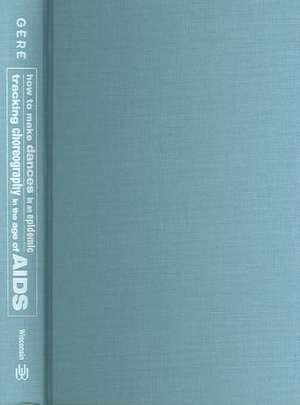How to Make Dances in an Epidemic: Tracking Choreography in the Age of AIDS
Autor David Gereen Limba Engleză Hardback – 14 sep 2004
Vezi toate premiile Carte premiată
Lambda Literary Awards (2004), de La Torre Bueno Prize (2005)
Gere expands the definition of choreography to analyze not only theatrical dances but also the protests conceived by ACT-UP and the NAMES Project AIDS quilt. These exist on a continuum in which dance, protest, and wrenching emotional expression have become essentially indistinguishable. Gere offers a portrait of gay male choreographers struggling to cope with AIDS and its meanings.
Preț: 448.39 lei
Preț vechi: 562.66 lei
-20% Nou
Puncte Express: 673
Preț estimativ în valută:
85.80€ • 89.59$ • 70.85£
85.80€ • 89.59$ • 70.85£
Carte indisponibilă temporar
Doresc să fiu notificat când acest titlu va fi disponibil:
Se trimite...
Preluare comenzi: 021 569.72.76
Specificații
ISBN-13: 9780299200800
ISBN-10: 0299200809
Pagini: 352
Ilustrații: 45 b-w photos
Dimensiuni: 152 x 229 x 25 mm
Greutate: 0.6 kg
Ediția:1
Editura: University of Wisconsin Press
Colecția University of Wisconsin Press
ISBN-10: 0299200809
Pagini: 352
Ilustrații: 45 b-w photos
Dimensiuni: 152 x 229 x 25 mm
Greutate: 0.6 kg
Ediția:1
Editura: University of Wisconsin Press
Colecția University of Wisconsin Press
Recenzii
“While the groundbreaking volume reflects a deep intellectual inquiry into the host of aesthetic and political tactics artists developed,...Gere’s lively, evocative prose and eye for the telling detail also make it a highly enjoyable read. [Gere] charts a new path for the dance scholar as impassioned activist.”—The Village Voice
"David Gere's How to Make Dances in an Epidemic is the definitive study of AIDS and dance, but its contribution extends well beyond these fields of inquiry. A model of impassioned scholarship, this book rescues a nearly forgotten queer archive from obscurity while demonstrating how the arts continue to make all the difference in our lives."—David Román, Professor of English and American Studies, University of Southern California
"This is a powerful and beautifully written book. Gere allows us to see dances as extremely rich events embodying politics, emotion, and art in varying ways, ranging from grief to insurgency. Gere’s own identity as a righteously insurgent gay man informs the book throughout in ways that are both passionate and illuminating—this is engaged scholarship at its best. Anyone interested in dance or in gay culture or in art and politics should, as I did, find this a fascinating book, impossible to put down."—Sally Banes, editor of Reinventing Dance in the 1960s
"David Gere is shifting and reshaping the paradigms of scholarship in performance studies, cultural studies, and feminist and queer studies."—Nayan Shah, author of Contagious Divides: Epidemics and Race in San Francisco’s Chinatown
"David Gere's How to Make Dances in an Epidemic is the definitive study of AIDS and dance, but its contribution extends well beyond these fields of inquiry. A model of impassioned scholarship, this book rescues a nearly forgotten queer archive from obscurity while demonstrating how the arts continue to make all the difference in our lives."—David Román, Professor of English and American Studies, University of Southern California
"This is a powerful and beautifully written book. Gere allows us to see dances as extremely rich events embodying politics, emotion, and art in varying ways, ranging from grief to insurgency. Gere’s own identity as a righteously insurgent gay man informs the book throughout in ways that are both passionate and illuminating—this is engaged scholarship at its best. Anyone interested in dance or in gay culture or in art and politics should, as I did, find this a fascinating book, impossible to put down."—Sally Banes, editor of Reinventing Dance in the 1960s
"David Gere is shifting and reshaping the paradigms of scholarship in performance studies, cultural studies, and feminist and queer studies."—Nayan Shah, author of Contagious Divides: Epidemics and Race in San Francisco’s Chinatown
Notă biografică
David Gere is associate professor in the Department of World Arts and Cultures at UCLA. A longtime dance critic, he has previously contributed essays to Loss within Loss and Dancing Desires, both published by the University of Wisconsin Press.
Descriere
David Gere, who came of age as a dance critic at the height of the AIDS epidemic, offers the first book to examine in depth the interplay of AIDS and choreography in the United States, specifically in relation to gay men. The time he writes about is one of extremes. A life-threatening medical syndrome is spreading, its transmission linked to sex. Blame is settling on gay men. What is possible in such a highly charged moment, when art and politics coincide?
Gere expands the definition of choreography to analyze not only theatrical dances but also the protests conceived by ACT-UP and the NAMES Project AIDS quilt. These exist on a continuum in which dance, protest, and wrenching emotional expression have become essentially indistinguishable. Gere offers a portrait of gay male choreographers struggling to cope with AIDS and its meanings.
Gere expands the definition of choreography to analyze not only theatrical dances but also the protests conceived by ACT-UP and the NAMES Project AIDS quilt. These exist on a continuum in which dance, protest, and wrenching emotional expression have become essentially indistinguishable. Gere offers a portrait of gay male choreographers struggling to cope with AIDS and its meanings.
Premii
- Lambda Literary Awards Nominee, 2004
- de La Torre Bueno Prize Special Citation, 2005
